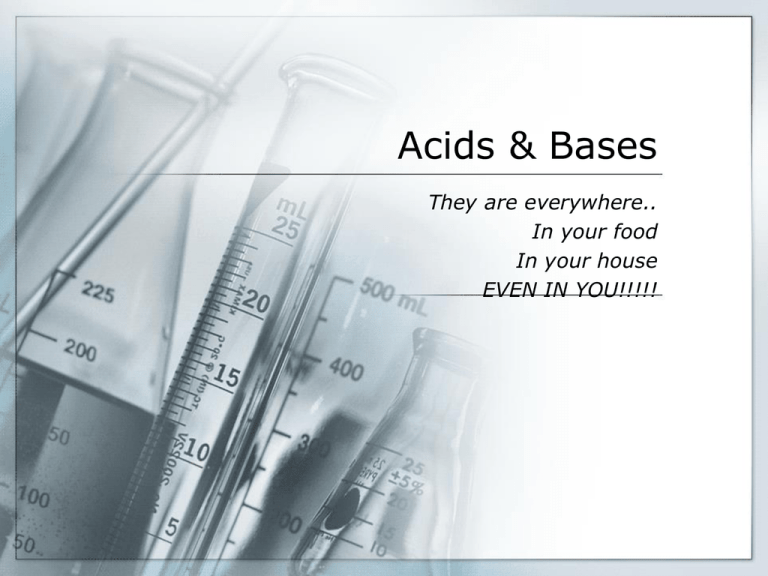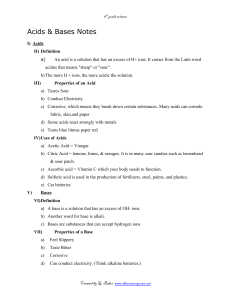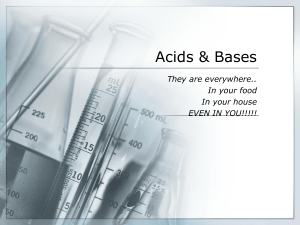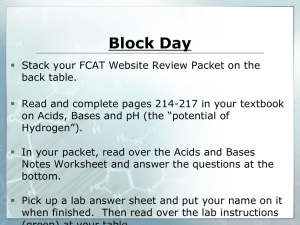Acids & Bases - Xenia Community Schools
advertisement

Acids & Bases They are everywhere.. In your food In your house EVEN IN YOU!!!!! Learning Targets #1: I can identify characteristics of acids and bases (including their respective ions). #2: I can identify a substance as an acid or a base given its name or a chemical formula. #3: I am able to describe the process of neutralization. #4: I know what the values in the pH scale represent and measure. What is an acid? An acid is a solution that has an excess of H+ ions. It comes from the Latin word acidus that means "sharp" or "sour". The more H + ions, the more acidic the solution. Properties of an Acid Picture from BBC Revision Bites http://www.bbc.co.uk/schools/ks3bitesize/science/chemistry/acids_b ases_1.shtml Tastes Sour Conduct Electricity Corrosive, which means they break down certain substances. Many acids can corrode fabric, skin,and paper Some acids react strongly with metals Turns blue litmus paper red Uses of Acids Acetic Acid = Vinegar Citric Acid = lemons, limes, & oranges. It is in many sour candies such as lemonhead & sour patch. Ascorbic acid = Vitamin C which your body needs to function. Sulfuric acid is used in the production of fertilizers, steel, paints, and plastics. Car batteries What is a base? A base is a solution that has an excess of OHions. Another word for base is alkali. Bases are substances that can accept hydrogen ions Properties of a Base Feel Slippery Taste Bitter Corrosive Can conduct electricity. (Think alkaline batteries.) React with metals. Turns red litmus paper blue. Uses of Bases Bases give soaps, ammonia, and many other cleaning products some of their useful properties. The OH- ions interact strongly with certain substances, such as dirt and grease. Chalk and oven cleaner are examples of familiar products that contain bases. Your blood is a basic solution. pH Scale pH is a measure of how acidic or basic a solution is. • pH measures the concentration of H+ (hydronium) ions • The pH scale ranges from 0 to 14. Acidic solutions have pH values below 7 A solution with a pH of 0 is very acidic. A solution with a pH of 7 is neutral. • Pure water has a pH of 7. • Basic solutions have pH values above 7. pH Scale • A change of 1 pH unit represents a ten-fold change in the acidity of the solution. • For example, if one solution has a pH of 1 and a second solution has a pH of 2, the first solution is not twice as acidic as the second— it is ten times more acidic. Acid – Base Reactions A reaction between an acid and a base is called neutralization. An acid-base mixture is not as acidic or basic as the individual starting solutions. Applications of Neutralisation Indigestion: Our stomach carries around hydrochloric acid. Too much of this leads to indigestion. To cure indigestion, you can neutralise the excess acid with baking soda or specialised indigestion • Insect Stings • Bee stings are acidic and can be neutralised with baking soda (bicarbonate of soda). • Wasp stings are alkaline and can be neutralised with vinegar. Acid – Base reactions When acids and bases react or neutralize, salts are formed. Each salt listed in this table can be formed by the reaction between an acid and a base.





